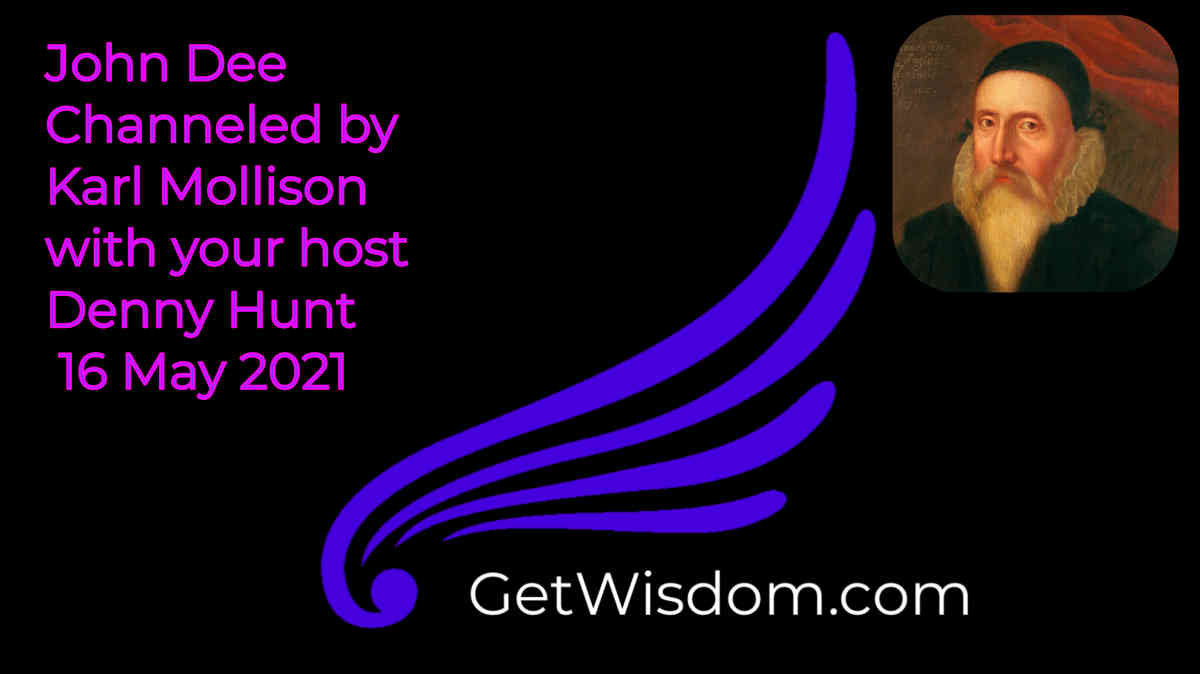
John Dee Channeled by Karl Mollison 16May2021
From https://en.wikipedia.org/wiki/John_Dee & https://mathshistory.st-andrews.ac.uk/Biographies/Dee/
John Dee 13 July 1527 – 1608 or 1609 was an Anglo-Welsh mathematician, astronomer, astrologer, teacher, occultist, and alchemist. He was the court astronomer for, and advisor to, Elizabeth I, and spent much of his time on alchemy, divination and Hermetic philosophy. As an antiquarian, he had one of the largest libraries in England at the time. As a political advisor, he advocated for the founding of English colonies in the New World to form a “British Empire”, a term he is credited with coining.
Edward Kelley entered Dee’s life in March of 1582. He was a medium who claimed to be able to contact angels and spirits and he did so by gazing into a crystal ball. Although this was not the first time Dee had been involved in such practices, at first he was still highly suspicious that Kelley’s visions were real. Two things convinced him, however: Kelley was highly skilled in his art, and secondly Dee so longed to understand the ultimate truth about the universe which he had failed to find by other means. The lack of reaction of others to his scientific work was also a factor, as was the fact that he had been accused of magic so often in his life. Dee became more and more deeply involved in conversing with angels and spirits through Kelley and, sadly, it dominated the latter part of his life.
This took place over a period of about five years. Several of the references give details of these conversations which Dee recorded in a diary. We note that in his diaries Dee refers to himself as Δ, a clever pun on the fact that is the Greek character for the letter “dee” and also a magical symbol.
Dee made a proposal to Queen Elizabeth for calendar reform in February 1583. He proposed the removal of eleven days to bring the calendar into line with the astronomical year. It was, of course, exactly the right course of action and Dee’s proposal gained support from several of Elizabeth’s advisors. However, the Archbishop of Canterbury opposed the scheme, partly because he was engaged in a longstanding argument with Elizabeth, partly because he considered such a scheme to be close to what the Catholic Church had adopted in the previous year. Dee’s scheme was, however, a better one than that adopted across Europe after the proclamation by Pope Gregory XIII. The Gregorian calendar was based on the date of the Council of Nicaea in 325, while Dee proposed a calendar with an astronomical base rather than a political one as he clearly pointed out. The failure of Dee’s calendar reform proposal would mean that England retained a calendar at odds with that in the rest of Europe until 1752.
Dee eventually left Elizabeth’s service and went on a quest for additional knowledge in the deeper realms of the occult and supernatural. He aligned himself with several individuals who may have been charlatans, travelled through Europe and was accused of spying for the English crown.
Dee was an intense Christian, but his religiosity was influenced by Hermetic and Platonic-Pythagorean doctrines pervasive in the Renaissance. He believed that numbers were the basis of all things and key to knowledge. From Hermeticism he drew a belief that man had the potential for divine power that could be exercised through mathematics. His goal was to help bring forth a unified world religion through the healing of the breach of the Roman Catholic and Protestant churches and the recapture of the pure theology of the ancients.
Upon his return to England, he found his home and library vandalised. He eventually returned to the Queen’s service, but was turned away when she was succeeded by James I.
He died in poverty in London and his gravesite is unknown.
John Dee explored many avenues to find a path to enlightenment. Was he successful?


